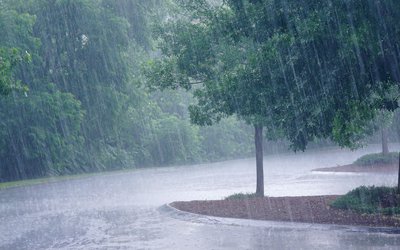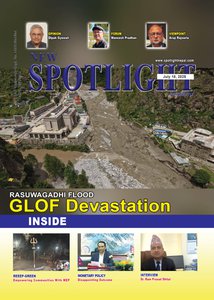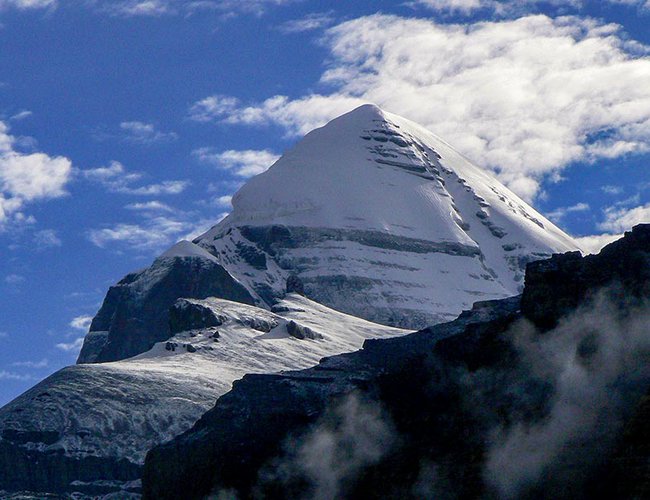
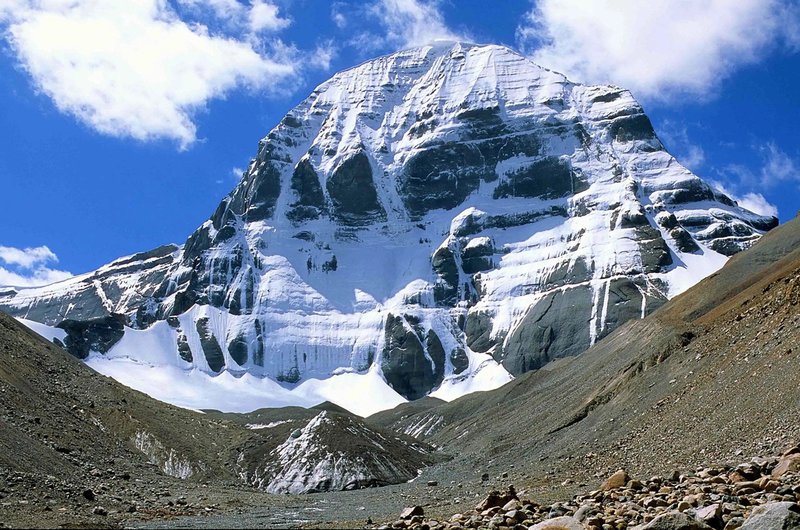

Located in the remote southwestern region of Tibet, Mount Kailash is believed to be the abode of Lord Shiva, where he resides with his consort Parvati (Bhavani). The mountain, often described as the axis mundi or the center of the universe, has been revered for millennia. Next to it lies Lake Mansarovar, a pristine and sacred freshwater lake, believed to be created by Lord Brahma in his mind—hence the name ‘Manas’ (mind) and ‘Sarovar’ (lake).
According to Hindu belief, a single parikrama (circumambulation) of Mount Kailash washes away the sins of a lifetime, while 108 circumambulations can lead to salvation (moksha). For Buddhists, Mount Kailash is the home of Demchok (Chakrasamvara), a representation of supreme bliss. Jains revere it as the place where their first Tirthankara, Rishabhadeva, attained liberation.
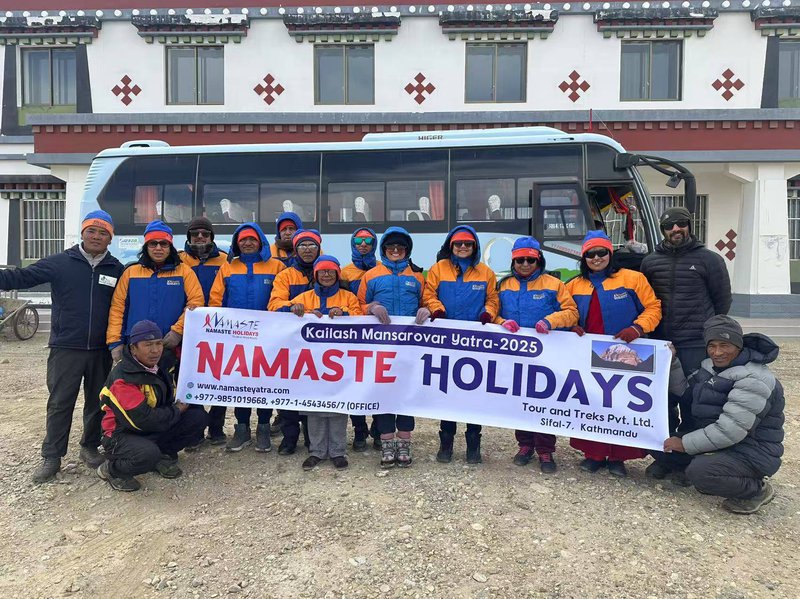
Spiritual Significance
The journey to Kailash Mansarovar is not just a religious duty—it is a deeply personal spiritual calling. It tests physical endurance and mental resilience while offering moments of awe, reflection, and connection with the divine.
Pilgrims often recite sacred mantras along the way, including:
“Karpoor Gauram Karunnaavataram
Sansaar Saaram Bhujgendra Haaram
Sadaa Vasantam Hridyaarvrinde
Bhavam Bhavaani Sahitam Namaami”
This powerful mantra is a prayer to Lord Shiva, describing him as the embodiment of purity (Karpoor Gauram), compassion (Karunnaavataram), and the essence of the universe. It honors his eternal presence in the hearts of devotees, along with Goddess Parvati.
The Journey
The trip to Kailash Mansarovar can be undertaken via several routes—through Nepal, India, or directly via Tibet (China). Each route is challenging due to high altitudes, unpredictable weather, and remote terrain. Yet, the hardships are embraced as part of the purification process.
Most pilgrims begin their journey with a dip in the holy waters of Lake Mansarovar, followed by the three-day circumambulation of Mount Kailash, which reaches altitudes over 18,000 feet at the Dolma La Pass. Despite the physical challenges, the sense of serenity and divine energy felt throughout the pilgrimage is unmatched.
Through this Shiva hymn, the glory and form of Sadashiva, Bhola Baba, Bholenath, the formless and pure Lord Shiva residing on Mount Kailash, is revealed. While chanting this sacred prayer, we were blessed with the rare opportunity to embark on the Kailash Mansarovar Yatra.
This sacred journey, which took place from Baisakh 10 to 19, 2082 B.S. (corresponding to April/May 2025), was initiated by our close family friends Batukrishna Upreti and his wife Uttara Upreti. From the beginning to the end, my wife Sarita Paudel stood by my side with unwavering support and companionship.
We were joined by our close relatives Gyanraj Pandey and Radha Pandey, as well as Batukrishna’s relatives, Dr. Ganeshraj Joshi and his wife Kamala Joshi. Together, we formed a close-knit group of eight devoted pilgrims.
Also part of our team were Ratna Sahi and Ratna Sahi, a devoted couple from Hadigaun in their seventies, along with Surendra Aryal from Syangja and Shreya Bharti from Pokhara, both in their forties. Our 10-day journey through the high Himalayan region, under the guidance of Basant Baral from Namaste Holidays, became an unforgettable chapter in all our lives—a blend of spiritual fulfillment, natural beauty, and deep companionship.
To speak honestly, the idea of this pilgrimage hadn’t even crossed our minds. Just a few weeks prior, we had returned from another spiritual tour to Ganga Sagar, Jagannath Puri, and the Jyotirlinga Baidyanath Dham in Jharkhand, India. Still recovering from that intense trip, we had no plans for another long journey—certainly not one as demanding as Kailash Mansarovar.
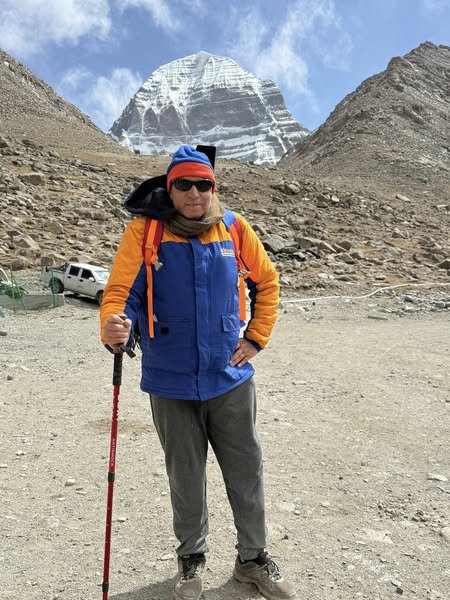
But fate had other plans. One morning during the second week of Chaitra (March/April), Batukrishna Upreti called and asked me directly:
“Do you want to go to Kailash Mansarovar?”
Though I am usually slow to make decisions, something within me responded without hesitation.
“Yes,” I said immediately.
My wife, Sarita, who was standing by the door, looked at me in astonishment. She could hardly believe her ears—she knew how unusual it was for me to decide so quickly, especially on something so momentous.
Later, I learned that Batukrishna had already discussed the Kailash Mansarovar trip with his wife Uttara before approaching me. As the leader of our group, he took full responsibility for all the arrangements—planning, logistics, and coordination—ensuring that every detail was managed with care and dedication to make the journey a success.
But this pilgrimage was far more than just a physical expedition or a climb through geographic elevation—it turned into a profound spiritual experience, filled with inner peace and divine energy.
The Kailash Mansarovar Yatra is surreal—an experience that feels beyond the realm of ordinary human imagination. The vast wilderness, otherworldly landscapes, and the sacred power of the snow-capped mountains and pristine lakes elevate this journey far above any ordinary adventure or leisure trip.
It becomes a test of endurance—a battle between the body and the altitude, as the thin air challenges every breath. But at the same time, it’s a cleansing of the mind and soul, brought on by the purity and silence of nature itself. It is in this space—between the struggle and the surrender—that many pilgrims, including myself, experience a deep sense of self-revelation and realization.
Mansarovar: Scriptural Glory and Spiritual Touch
The name ‘Mansarovar’ comes from the Sanskrit words “Manas” (mind or intellect) and “Sarovar” (lake). According to ancient Hindu texts, this sacred lake was created by Lord Brahma, and is described as the heavenly abode of Lord Vishnu.
Religious traditions say that during the auspicious Brahma Muhurta—the hour just before sunrise—the Saptarishis (seven great sages) and various deities descend to bathe in the lake’s crystal-clear waters. An early morning bath at Mansarovar is believed to be incredibly meritorious, bringing blessings that transcend lifetimes.
As per Hindu scriptures, a single dip in this holy lake can cleanse the sins of seven lifetimes, and even a single sip of its sacred water is said to grant Shivahood—the state of divine consciousness and liberation.
Rakshas Tal: Symbol of Darkness and Duality
During our circumambulation of Mansarovar, we reached a slightly elevated point on the western side, from where we could clearly see Rakshas Tal—the crescent-shaped Lake of Demons—lying directly opposite. Unlike the sacred Mansarovar, this saline lake is considered tamasic (symbolizing ignorance and darkness) in Hindu tradition.
The two lakes are connected by a small river, Ganga Chu, which legend says was created by the Saptarishis to purify the negative energies of Rakshas Tal using the divine waters of Mansarovar.
According to Hindu scriptures, Ravana, the king of Lanka, created Rakshas Tal to perform severe penance to Lord Shiva. It’s believed he offered one of his ten heads daily on the islands within the lake, and on the tenth day, Shiva, pleased with his devotion, granted him a powerful boon.
At an altitude of 4,575 meters and covering about 250 square kilometers, Rakshas Tal appears lifeless—devoid of vegetation and wildlife—and is traditionally considered inauspicious. Bathing in it is believed to invite sin, unlike the purifying waters of Mansarovar.
Though separated by just 200 meters, Mansarovar and Rakshas Tal represent opposing forces—light and darkness, purity and penance—standing side by side as a powerful symbol of spiritual duality.
A highway now runs alongside Rakshas Tal, improving access between Mansarovar and
Features of the Kailash Mansarovar Tour
Organized by Namaste Holidays, the Kailash Mansarovar Tour brought us face-to-face with the sacred Mount Kailash, which rises majestically to 6,675 meters. The journey includes the opportunity to perform the revered “Kora” (circumambulation) around the mountain, offering breathtaking views of remote Himalayan landscapes.
Unlike other mountain regions, the route to Kailash is rugged, remote, and deeply spiritual, passing through the isolated terrain of the Tibetan plateau. The drive is rich with Buddhist culture—prayer flags, ancient monasteries, and devout pilgrims reflecting the deep spiritual heritage of the region.
Nestled in the shadow of Mount Kailash is the serene Lake Mansarovar, believed to have healing powers. A dip in its holy waters is thought to cleanse the body and soul.
Source of Major Rivers
Mount Kailash is the origin of four of Asia’s great rivers: the Indus, Sutlej, and Brahmaputra in India, and the Karnali in Nepal. These rivers, flowing from the sacred mountain, nourish millions across South Asia.
Spiritual Significance Across Religions
For Hindus, Mount Kailash is the divine abode of Lord Shiva. Buddhists revere it as the home of Buddha Demchok, while Jains believe it is where Rishabhadeva attained Nirvana. For followers of the Bon tradition, it is a powerful spiritual center. Its universal sacredness draws pilgrims and seekers from around the world.
Highlights of the Yatra
The 10-day Kailash Mansarovar Yatra offered a rich blend of natural beauty, spiritual depth, and cultural discovery, spanning across Nepal and Tibet.
- Tibet: Once across the border, the journey through Kyirong Valley reveals the unique lifestyle and spiritual traditions of the Tibetan people.
- Mount Kailash: Standing at 6,638 meters, the mountain marks the spiritual climax of the yatra. Pilgrims undertake the revered Kora (circumambulation), believed to cleanse sins and bring inner transformation.
- Lake Mansarovar: At the base of Kailash, the serene lake is considered holy and purifying, attracting those seeking healing and peace.
Kailash Mansarovar Yatra Difficulty
The Kailash Mansarovar Yatra via Kyirong (Nepal) is considered moderate to challenging, primarily due to high altitude and remote terrain. Altitudes often exceed 15,000 feet, making altitude sickness a real concern, with symptoms like headaches, nausea, and dizziness. Proper acclimatization, a gradual ascent, and necessary medications are essential.
The route offers spectacular scenery but involves winding roads and rugged terrain, requiring a sturdy vehicle and experienced driver. Weather in the Himalayas is unpredictable, with sudden rain and cold, even in summer—so travelers must be prepared for extreme conditions, especially cold nights.
Accommodations, particularly in Derapuk and Zuthulpuk, are basic, with limited facilities and often inadequate washrooms. It’s advisable to carry essentials like medications, warm clothing, and personal hygiene supplies.
Despite these challenges, the yatra is a profound spiritual and scenic journey, offering both inner transformation and unforgettable Himalayan beauty.
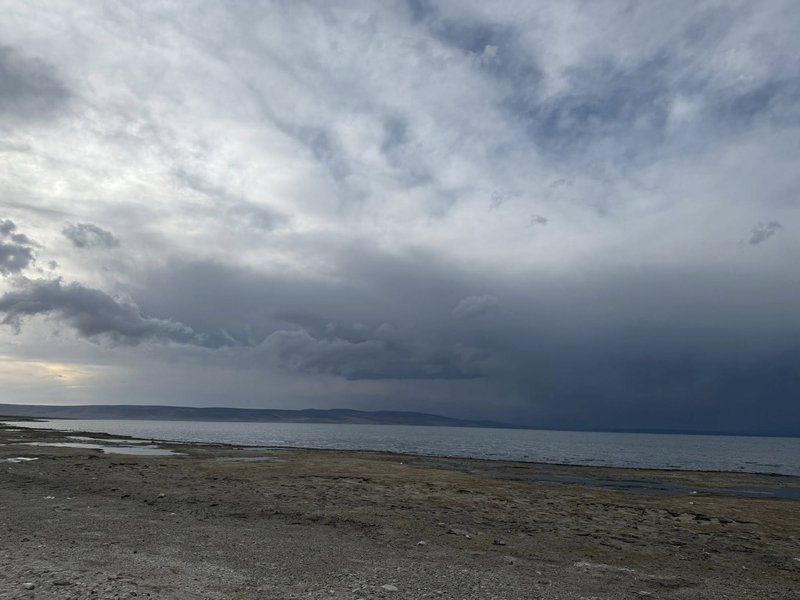
Travel Itinerary:
Day 1: Kathmandu to Syabrubesi or Timure via Trishuli and Dhunche (7 hours)
Our journey will begin from Kathmandu at 7 AM. We will travel through Trishuli and Dhunche and reach either Syabrubesi or Timure after approximately 7 hours of driving, where we will stay overnight.
Day 2: Syabrubesi or Timure to Kerung via Rasuwagadhi Border (2,800 meters)
After morning tea and snacks, we will proceed towards the Rasuwagadhi border. After completing the necessary immigration formalities at the border and meeting our Chinese guide, we will change buses and continue our journey to Kerung. It will take about 1 hour from the Tibet border to reach Kerung, where we will stay overnight.
Day 3: Kerung to Saga (170 kilometers | 5 hours | 4,300 meters elevation)
Today's journey will take approximately 6 hours. Along the way, we will witness scenic spots like Ru-Pemba Mountain (4,500 m), beautiful waterfalls, the old Kerung village, Khumdang-La Pass (5,200 m), Salt Lake, Yalap Shang village, and high Himalayan peaks. After crossing the Brahmaputra River, we will arrive in Saga for an overnight stay.
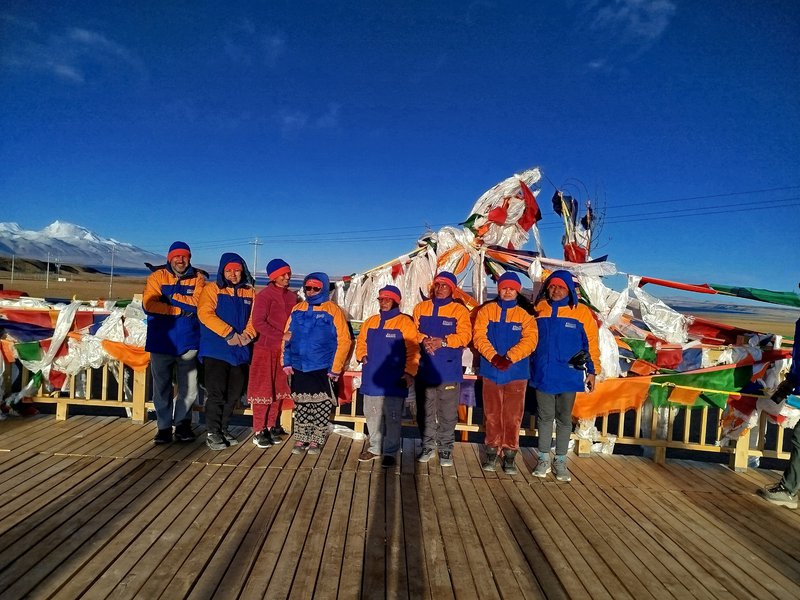
Day 4: Saga to Mansarovar (510 kilometers | 8 hours | 4,600 meters elevation)
After morning refreshments, we will start our journey around 8:30 AM Chinese time toward the holy site of Mansarovar. The bus ride will last 8–9 hours, passing through various Tibetan villages such as Old Dongba, New Dongba, and Paryang, and crossing the high Mayumla Pass (5,200 m). Upon reaching the eastern shore of Lake Mansarovar, we will obtain entry tickets, change to another bus, and start the clockwise circumambulation (parikrama) of the lake. On the way, we will see Mount Gurla Mandhata and Rakshas Tal before arriving at Chiu Gompa on the western side of the lake for an overnight stay.
Day 5: Mansarovar to Darchen (35 kilometers | 1 hour | 4,700 meters elevation)
In the morning, we will bathe, perform worship, and sing devotional hymns at the sacred Lake Mansarovar. After lunch, we will head to Darchen. On this day, travelers who are unable to complete the Kailash Parikrama (circumambulation) on foot should arrange for horses and porters as needed.
Day 6: Darchen to Yam Dwar by bus (4 kilometers | 20 minutes), then Yam Dwar to Deraphuk on foot (13 kilometers | 5 hours | 4,950 meters elevation)
After morning tea and snacks today, the circumambulation (parikrama) of Mount Kailash begins.
All pilgrims will be taken by bus to Yam Dwar for a visit. After the visit, those continuing the journey on foot will depart toward Deraphuk, while those not walking will return to Darchen and stay there for two nights.
Day 7: Deraphuk to Zuthulphuk via Dolma La and Gauri Kund (9 hours on foot | 22 kilometers | 4,850 meters elevation)
Today is the most challenging day of the journey. We will begin early in the morning and trek throughout the day, crossing the highest point of the trek at 5,600 meters. After this long day of walking, we will reach Zuthulphuk for an overnight stay.
Day 8: Zuthulphuk – Darchen – Saga (480 kilometers | 8 hours)
After an early morning tea or coffee, we will walk for around 3 hours to reach a place called Zhongba. From there, we will take a short bus ride to reach Darchen, reunite with those who waited, have some refreshments, and then proceed to Saga.
Day 9: Saga to Kerung (170 kilometers | 5 hours)
Day 10: Kerung to Rasuwagadhi (1 hour) – Syabrubesi – Dhunche – Kathmandu (6 hours)
Today marks the final day of our journey. We will cross the border early in the morning and travel directly back to Kathmandu, concluding our pilgrimage upon arrival.
Information about the Kailash Mansarovar Yatra
Mount Kailash and Lake Mansarovar, located in the western region of Tibet — an autonomous region of China — are sacred pilgrimage sites for followers of Hinduism, Buddhism, Jainism, and the Bon religion. Every year, thousands of pilgrims visit this holy land to seek spiritual blessings.
Mount Kailash stands at an altitude of approximately 6,714 meters, while Lake Mansarovar is situated at an elevation of 4,600 meters. The lake spans an area of 320 square kilometers and has a depth of about 100 meters.
Lake Mansarovar is formed by the waters flowing from Mount Kailash and Mount Gurla Mandhata. Interestingly, several major rivers are believed to originate from this lake — Brahmaputra to the east, Indus to the north, Sutlej to the west, and Karnali to the south.
One fascinating aspect of circumambulating Lake Mansarovar is that no water is seen flowing outward from the lake; yet the rivers are believed to originate from within the lake itself, suggesting that they emerge from its internal sources.

Keshab Poudel
Poudel is the editor of New Spotlight Magazine.
- LIEUTENANT COLONEL JP CROSS: Centenary Birthday
- Aug 06, 2025
- Israeli Officials Say That 20 People Including Bipin Joshi Are Alive
- Aug 05, 2025
- RASUWAGADHI FLOOD: GLOF Devastation
- Jul 20, 2025
- ERC Nepal Is Focused On Expanding Distribution And Transmission To The Private Sector: ERC Chair Dr. Dhital
- Jul 06, 2025
- FOURTH PROFESSOR Y.N. KHANAL LECTURE: Nepal-China Relations
- Jun 23, 2025










